Comparative Genome Sequence Analyses of Geographic Samples of Aspergillus fumigatus—Relevance for Amphotericin B Resistance
Abstract
1. Introduction
2. Materials and Methods
2.1. Isolates
2.2. Antifungal Susceptibility Testing
2.3. DNA Extraction and Whole-Genome Sequencing
2.4. Genome Sequences from NCBI
2.5. SNP Identification and Annotation
2.6. SNP Distribution along Chromosomes
2.7. Phylogenetic Analysis
2.8. Genome-Wide Association Study
2.9. Data Availability
3. Results
3.1. AMB Susceptibility
3.2. SNP Distribution along Chromosomes
3.3. Phylogenetic Analysis
3.4. Genes of Interest
3.5. Genome-Wide Association Analysis
4. Discussion
Supplementary Materials
Author Contributions
Funding
Acknowledgments
Conflicts of Interest
References
- Latgé, J.P. Aspergillus fumigatus and Aspergillosis. Clin. Microbiol. Rev. 1999, 12, 310–350. [Google Scholar] [CrossRef]
- Dagenais, T.R.T.; Keller, N.P. Pathogenesis of Aspergillus fumigatus in Invasive Aspergillosis. Clin. Microbiol. Rev. 2009, 22, 447–465. [Google Scholar] [CrossRef] [PubMed]
- Murphy, J.W.; Friedman, H.; Bendinelli, M. Fungal infections and immune responses; Springer Science & Business Media: Berlin/Heidelberg, Germany, 2013; ISBN 1-4899-2400-0. [Google Scholar]
- Ashu, E.E.; Hagen, F.; Chowdhary, A.; Meis, J.F.; Xu, J. Global Population Genetic Analysis of Aspergillus fumigatus. mSphere 2017, 2, e00019-17. [Google Scholar] [CrossRef] [PubMed]
- Korfanty, G.A.; Teng, L.; Pum, N.; Xu, J. Contemporary Gene Flow is a Major Force Shaping the Aspergillus fumigatus Population in Auckland, New Zealand. Mycopathologia 2019, 184, 479–492. [Google Scholar] [CrossRef] [PubMed]
- Ashu, E.E.; Korfanty, G.A.; Xu, J. Evidence of unique genetic diversity in Aspergillus fumigatus isolates from Cameroon. Mycoses 2017, 60, 739–748. [Google Scholar] [CrossRef]
- Ashu, E.E.; Korfanty, G.A.; Samarasinghe, H.; Pum, N.; You, M.; Yamamura, D.; Xu, J. Widespread amphotericin B-resistant strains of Aspergillus fumigatus in Hamilton, Canada. Infect. Drug Resist. 2018, 11, 1549–1555. [Google Scholar] [CrossRef]
- Ashu, E.E.; Kim, G.Y.; Roy-Gayos, P.; Dong, K.; Forsythe, A.; Giglio, V.; Korfanty, G.; Yamamura, D.; Xu, J. Limited evidence of fungicide-driven triazole-resistant Aspergillus fumigatus in Hamilton, Canada. Can. J. Microbiol. 2017, 64, 119–130. [Google Scholar] [CrossRef]
- Resendiz Sharpe, A.; Lagrou, K.; Meis, J.F.; Chowdhary, A.; Lockhart, S.R.; Verweij, P.E.; on behalf of the ISHAM/ECMM Aspergillus Resistance Surveillance Working Group. Triazole resistance surveillance in Aspergillus fumigatus. Med. Mycol. 2018, 56, S83–S92. [Google Scholar] [CrossRef]
- Verweij, P.E.; Ananda-Rajah, M.; Andes, D.; Arendrup, M.C.; Brüggemann, R.J.; Chowdhary, A.; Cornely, O.A.; Denning, D.W.; Groll, A.H.; Izumikawa, K.; et al. International expert opinion on the management of infection caused by azole-resistant Aspergillus fumigatus. Drug Resist. Updat. 2015, 21–22, 30–40. [Google Scholar] [CrossRef]
- Sugar, A.M. Use of amphotericin B with azole antifungal drugs: What are we doing? Antimicrob. Agents Chemother. 1995, 39, 1907–1912. [Google Scholar] [CrossRef][Green Version]
- Zavrel, M.; Esquivel, B.D.; White, T.C. The Ins and Outs of Azole Antifungal Drug Resistance: Molecular Mechanisms of Transport. In Handbook of Antimicrobial Resistance; Berghuis, A., Matlashewski, G., Wainberg, M.A., Sheppard, D., Eds.; Springer: New York, NY, USA, 2017; pp. 423–452. ISBN 978-1-4939-0694-9. [Google Scholar]
- Guinea, J.; Peláez, T.; Alcalá, L.; Ruiz-Serrano, M.J.; Bouza, E. Antifungal Susceptibility of 596 Aspergillus fumigatus Strains Isolated from Outdoor Air, Hospital Air, and Clinical Samples: Analysis by Site of Isolation. Antimicrob. Agents Chemother. 2005, 49, 3495–3497. [Google Scholar] [CrossRef][Green Version]
- Tashiro, M.; Izumikawa, K.; Minematsu, A.; Hirano, K.; Iwanaga, N.; Ide, S.; Mihara, T.; Hosogaya, N.; Takazono, T.; Morinaga, Y.; et al. Antifungal Susceptibilities of Aspergillus fumigatus Clinical Isolates Obtained in Nagasaki, Japan. Antimicrob. Agents Chemother. 2012, 56, 584–587. [Google Scholar] [CrossRef] [PubMed]
- Reichert-Lima, F.; Lyra, L.; Pontes, L.; Moretti, M.L.; Pham, C.D.; Lockhart, S.R.; Schreiber, A.Z. Surveillance for azoles resistance in Aspergillus spp. highlights a high number of amphotericin B-resistant isolates. Mycoses 2018, 61, 360–365. [Google Scholar] [CrossRef] [PubMed]
- Dunkel, N.; Blass, J.; Rogers, P.D.; Morschhäuser, J. Mutations in the multi-drug resistance regulator MRR1, followed by loss of heterozygosity, are the main cause of MDR1 overexpression in fluconazole-resistant Candida albicans strains. Mol. Microbiol. 2008, 69, 827–840. [Google Scholar] [CrossRef]
- Lockhart, S.R.; Etienne, K.A.; Vallabhaneni, S.; Farooqi, J.; Chowdhary, A.; Govender, N.P.; Colombo, A.L.; Calvo, B.; Cuomo, C.A.; Desjardins, C.A.; et al. Simultaneous Emergence of Multidrug-Resistant Candida auris on 3 Continents Confirmed by Whole-Genome Sequencing and Epidemiological Analyses. Clin. Infect. Dis. 2017, 64, 134–140. [Google Scholar] [CrossRef] [PubMed]
- Zheng, Z.; Hou, Y.; Cai, Y.; Zhang, Y.; Li, Y.; Zhou, M. Whole-genome sequencing reveals that mutations in myosin-5 confer resistance to the fungicide phenamacril in Fusarium graminearum. Sci. Rep. 2015, 5, 8248. [Google Scholar] [CrossRef]
- Camps, S.M.T.; Dutilh, B.E.; Arendrup, M.C.; Rijs, A.J.M.M.; Snelders, E.; Huynen, M.A.; Verweij, P.E.; Melchers, W.J.G. Discovery of a hapE Mutation That Causes Azole Resistance in Aspergillus fumigatus through Whole Genome Sequencing and Sexual Crossing. PLOS ONE 2012, 7, e50034. [Google Scholar] [CrossRef] [PubMed]
- Hagiwara, D.; Takahashi, H.; Watanabe, A.; Takahashi-Nakaguchi, A.; Kawamoto, S.; Kamei, K.; Gonoi, T. Whole-Genome Comparison of Aspergillus fumigatus Strains Serially Isolated from Patients with Aspergillosis. J. Clin. Microbiol. 2014, 52, 4202–4209. [Google Scholar] [CrossRef]
- Abdolrasouli, A.; Rhodes, J.; Beale, M.A.; Hagen, F.; Rogers, T.R.; Chowdhary, A.; Meis, J.F.; Armstrong-James, D.; Fisher, M.C. Genomic Context of Azole Resistance Mutations in Aspergillus fumigatus Determined Using Whole-Genome Sequencing. mBio 2015, 6, e00536-15. [Google Scholar] [CrossRef]
- Reference Method for Broth Dilution Antifungal Susceptibility Testing of Filamentous Fungi. Clinical and Laboratory Standards Institute, 2008. Available online: https://clsi.org/media/1455/m38a2_sample.pdf (accessed on 26 September 2020).
- Lass-Flörl, C. Susceptibility testing in Aspergillus species complex. Clin. Microbiol. Infect. 2014, 20, 49–53. [Google Scholar] [CrossRef]
- Xu, J.; Ramos, A.R.; Vilgalys, R.; Mitchell, T.G. Clonal and Spontaneous Origins of Fluconazole Resistance in Candida albicans. J. Clin. Microbiol. 2000, 38, 1214–1220. [Google Scholar] [CrossRef] [PubMed]
- Babraham Bioinformatics-FastQC A Quality Control tool for High Throughput Sequence Data. Available online: https://www.bioinformatics.babraham.ac.uk/projects/fastqc/ (accessed on 26 September 2020).
- Bolger, A.M.; Lohse, M.; Usadel, B. Trimmomatic: A flexible trimmer for Illumina sequence data. Bioinformatics 2014, 30, 2114–2120. [Google Scholar] [CrossRef] [PubMed]
- Warn, P.A.; Sharp, A.; Morrissey, G.; Denning, D.W. Activity of aminocandin (IP960; HMR3270) compared with amphotericin B, itraconazole, caspofungin and micafungin in neutropenic murine models of disseminated infection caused by itraconazole-susceptible and -resistant strains of Aspergillus fumigatus. Int. J. Antimicrob. Agents 2010, 35, 146–151. [Google Scholar] [CrossRef]
- Li, H. Aligning sequence reads, clone sequences and assembly contigs with BWA-MEM. Q-Bio 2013, arXiv:1303.3997. [Google Scholar]
- Picard Tools-By Broad Institute. Available online: http://broadinstitute.github.io/picard/ (accessed on 25 September 2020).
- Garrison, E.; Marth, G. Haplotype-based variant detection from short-read sequencing. Q-Bio 2012, arXiv:120.73907. [Google Scholar]
- GitHub - Vcflib/Vcflib: C++ Library and Cmdline Tools for Parsing and Manipulating VCF Files. Available online: https://github.com/vcflib/vcflib (accessed on 25 September 2020).
- Cingolani, P.; Platts, A.; Wang, L.L.; Coon, M.; Nguyen, T.; Wang, L.; Land, S.J.; Lu, X.; Ruden, D.M. A program for annotating and predicting the effects of single nucleotide polymorphisms, SnpEff: SNPs in the genome of Drosophila melanogaster strain w1118; iso-2; iso-3. Fly (Austin) 2012, 6, 80–92. [Google Scholar] [CrossRef] [PubMed]
- Modern Visualization for the Data Era. Available online: https://plot.ly (accessed on 25 September 2020).
- Stamatakis, A. RAxML version 8: A tool for phylogenetic analysis and post-analysis of large phylogenies. Bioinformatics 2014, 30, 1312–1313. [Google Scholar] [CrossRef] [PubMed]
- Letunic, I.; Bork, P. Interactive Tree Of Life (iTOL) v4: Recent updates and new developments. Nucleic Acids Res. 2019, 47, W256–W259. [Google Scholar] [CrossRef]
- R: The R Project for Statistical Computing. Available online: https://www.r-project.org/ (accessed on 28 September 2020).
- Chang, C.C.; Chow, C.C.; Tellier, L.C.; Vattikuti, S.; Purcell, S.M.; Lee, J.J. Second-generation PLINK: Rising to the challenge of larger and richer datasets. GigaScience 2015, 4, 7. [Google Scholar] [CrossRef] [PubMed]
- Garcia-Rubio, R.; Monzon, S.; Alcazar-Fuoli, L.; Cuesta, I.; Mellado, E. Genome-Wide Comparative Analysis of Aspergillus fumigatus Strains: The Reference Genome as a Matter of Concern. Genes 2018, 9, 363. [Google Scholar] [CrossRef] [PubMed]
- Mesa-Arango, A.C.; Scorzoni, L.; Zaragoza, O. It only takes one to do many jobs: Amphotericin B as antifungal and immunomodulatory drug. Front. Microbiol. 2012, 3. [Google Scholar] [CrossRef]
- Young, L.Y.; Hull, C.M.; Heitman, J. Disruption of Ergosterol Biosynthesis Confers Resistance to Amphotericin B in Candida lusitaniae. Antimicrob. Agents Chemother. 2003, 47, 2717–2724. [Google Scholar] [CrossRef] [PubMed]
- Linares, C.E.B.; Giacomelli, S.R.; Altenhofen, D.; Alves, S.H.; Morsch, V.M.; Schetinger, M.R.C. Fluconazole and amphotericin-B resistance are associated with increased catalase and superoxide dismutase activity in Candida albicans and Candida dubliniensis. Rev. Soc. Bras. Med. Trop. 2013, 46, 752–758. [Google Scholar] [CrossRef]
- Jung, K.-W.; Bahn, Y.-S. The Stress-Activated Signaling (SAS) Pathways of a Human Fungal Pathogen, Cryptococcus neoformans. Mycobiology 2009, 37, 161–170. [Google Scholar] [CrossRef] [PubMed]
- Jackson-Hayes, L.; Atiq, Z.; Betton, B.; Freyaldenhoven, W.T.; Myers, L.; Olsen, E.; Hill, T.W. Aspergillus nidulans protein kinase C forms a complex with the formin SepA that is involved in apical growth and septation. Fungal Genet. Biol. FG B 2019, 122, 21–30. [Google Scholar] [CrossRef] [PubMed]
- Harris, S.D.; Hamer, L.; Sharpless, K.E.; Hamer, J.E. The Aspergillus nidulans sepA gene encodes an FH1/2 protein involved in cytokinesis and the maintenance of cellular polarity. EMBO J. 1997, 16, 3474–3483. [Google Scholar] [CrossRef]
- Steinchen, W.; Lackner, G.; Yasmin, S.; Schrettl, M.; Dahse, H.-M.; Haas, H.; Hoffmeister, D. Bimodular Peptide Synthetase SidE Produces Fumarylalanine in the Human Pathogen Aspergillus fumigatus. Appl. Environ. Microbiol. 2013, 79, 6670–6676. [Google Scholar] [CrossRef][Green Version]
- Brandon, M.; Howard, B.; Lawrence, C.; Laubenbacher, R. Iron acquisition and oxidative stress response in Aspergillus fumigatus. BMC Syst. Biol. 2015, 9, 19. [Google Scholar] [CrossRef]
- Hokken, M.W.J.; Zwaan, B.J.; Melchers, W.J.G.; Verweij, P.E. Facilitators of adaptation and antifungal resistance mechanisms in clinically relevant fungi. Fungal Genet. Biol. 2019, 132, 103254. [Google Scholar] [CrossRef]
- Cornet, M.; Mallat, H.; Somme, D.; Guérot, E.; Kac, G.; Mainardi, J.L.; Fornes, P.; Gutmann, L.; Lavarde, V. Fulminant invasive pulmonary aspergillosis in immunocompetent patients—a two-case report. Clin. Microbiol. Infect. 2003, 9, 1224–1227. [Google Scholar] [CrossRef]
- Trof, R.J.; Beishuizen, A.; Debets-Ossenkopp, Y.J.; Girbes, A.R.J.; Groeneveld, A.B.J. Management of invasive pulmonary aspergillosis in non-neutropenic critically ill patients. Intensive Care Med. 2007, 33, 1694–1703. [Google Scholar] [CrossRef] [PubMed]
- Meersseman, W.; Vandecasteele, S.J.; Wilmer, A.; Verbeken, E.; Peetermans, W.E.; Van Wijngaerden, E. Invasive aspergillosis in critically ill patients without malignancy. Am. J. Respir. Crit. Care Med. 2004, 170, 621–625. [Google Scholar] [CrossRef] [PubMed]
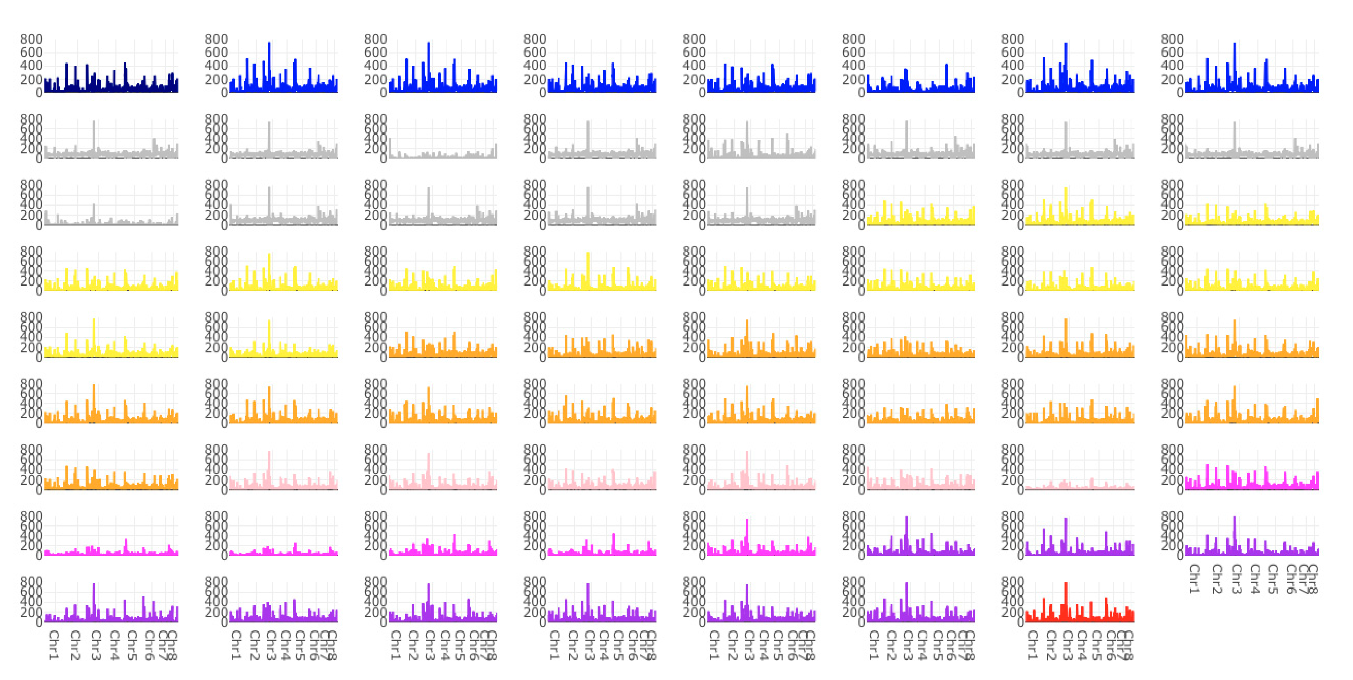
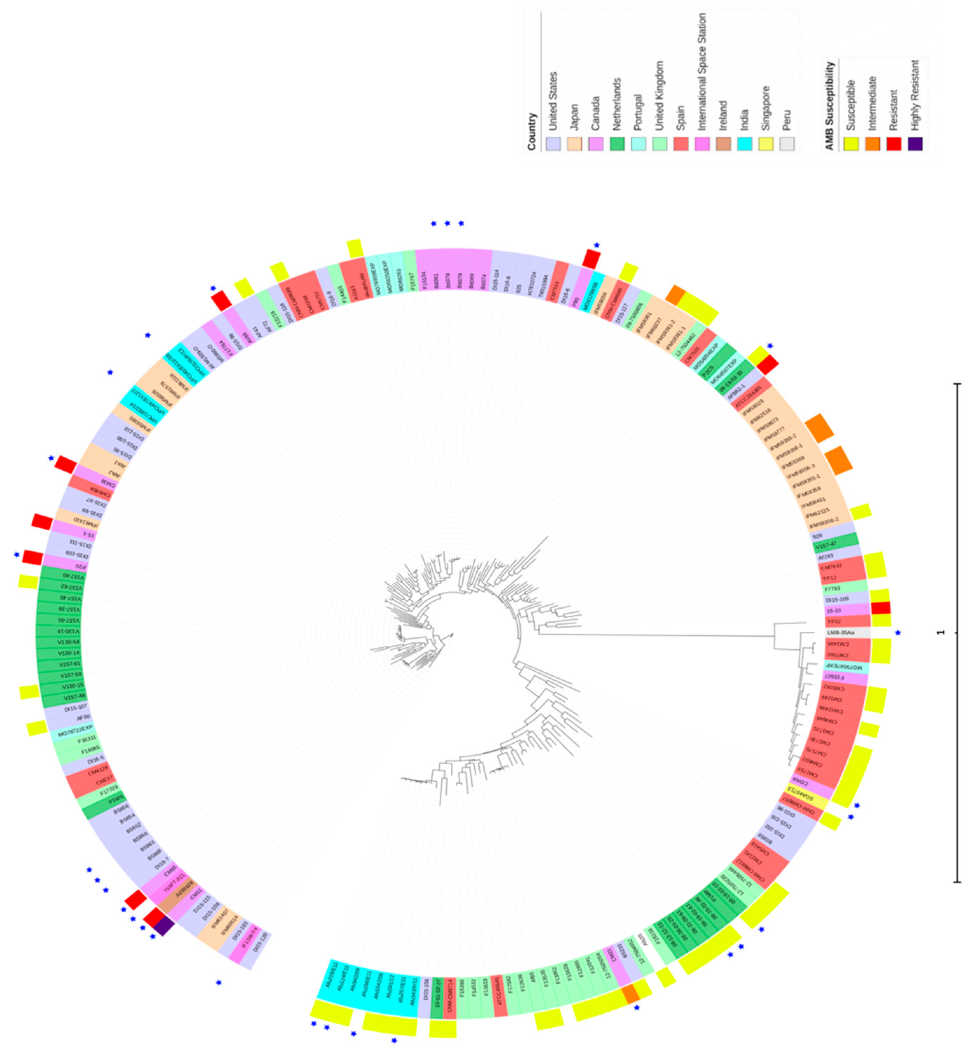
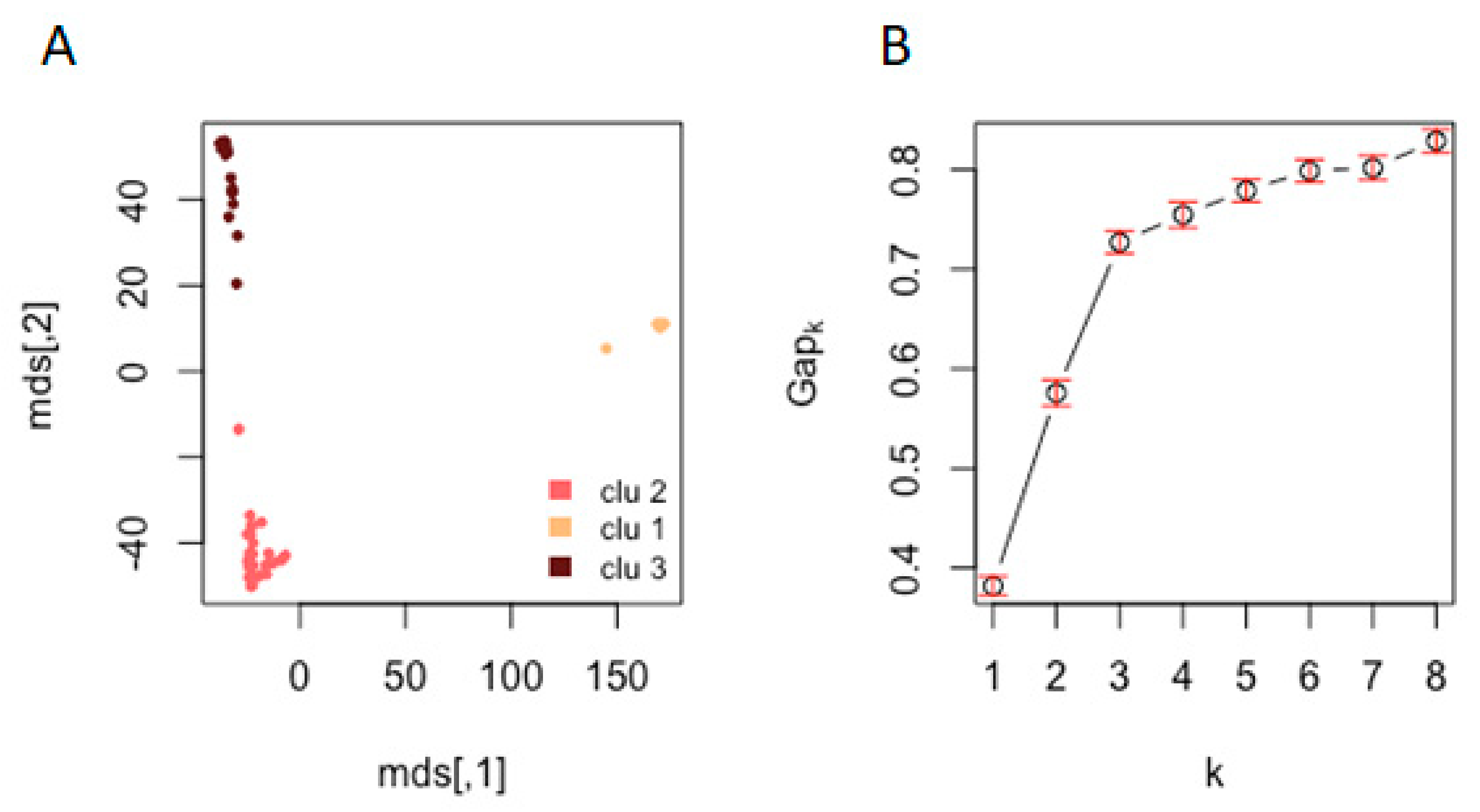
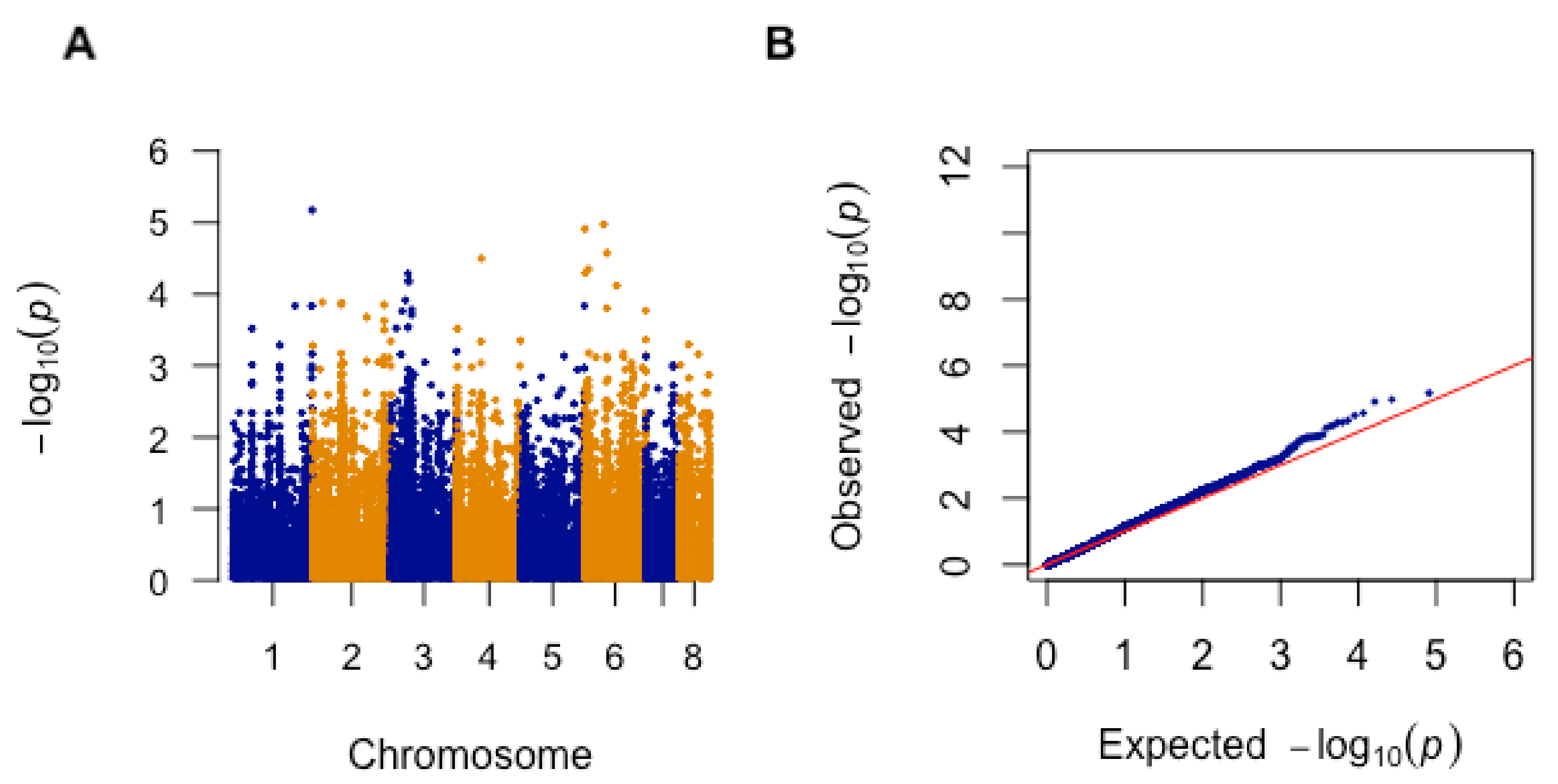
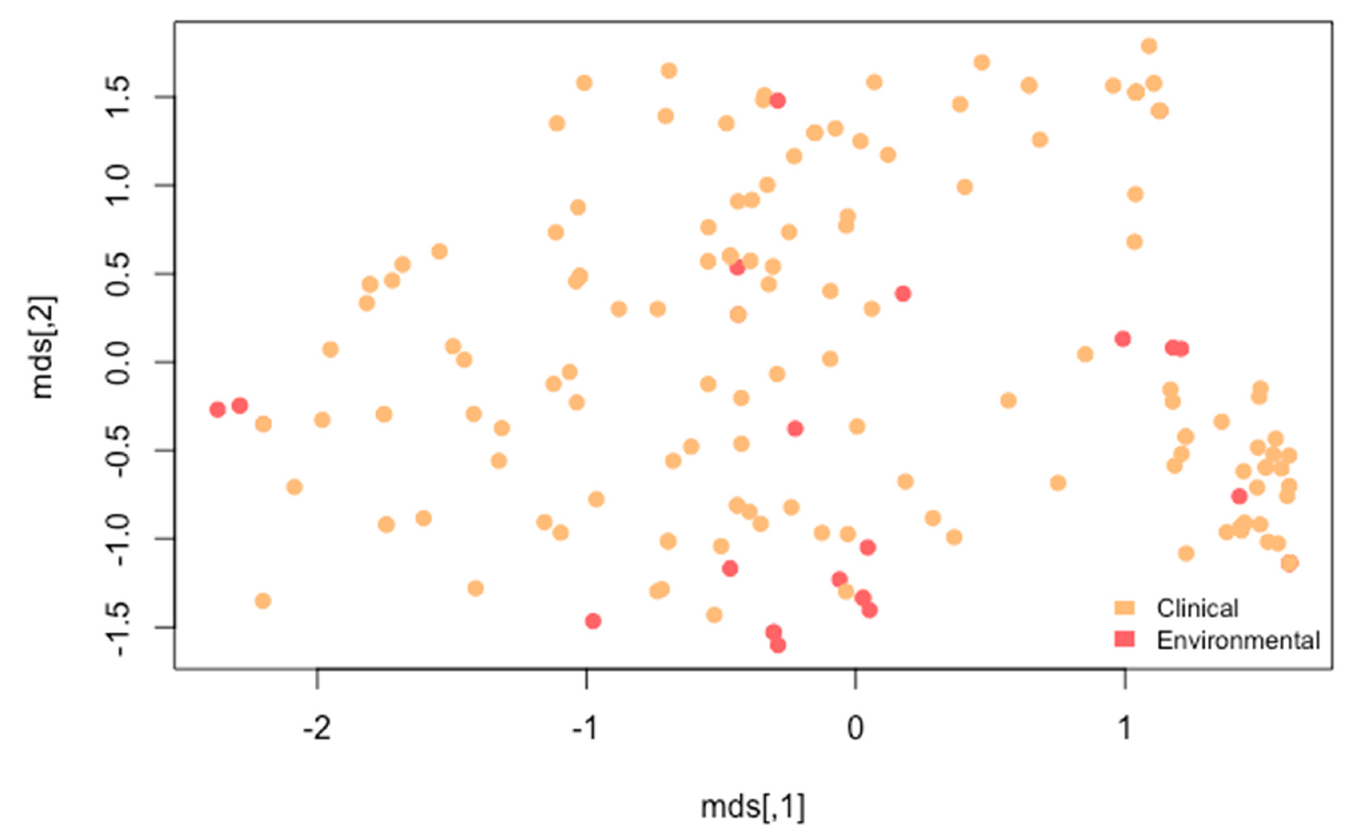
| Samples | BioSample Accession Number | City, Country | Alleles at the Nine Consensus SSR Loci | AMB MIC (mg/L) | ||||||||
|---|---|---|---|---|---|---|---|---|---|---|---|---|
| 2A | 2B | 2C | 3A | 3B | 3C | 4A | 4B | 4C | ||||
| CON4 | SAMN16550813 | Hamilton, Canada | 21 | 13 | 11 | 5 | 24 | 46 | 11 | 9 | 10 | 1 |
| CM21 | SAMN16550814 | Hamilton, Canada | 6 | 25 | 8 | 32 | 5 | 6 | 23 | 8 | 9 | 2 |
| CM65 | SAMN16550815 | Hamilton, Canada | 8 | 26 | 10 | 15 | 20 | 43 | 7 | 7 | 8 | 4 |
| P80 | SAMN16550816 | Hamilton, Canada | 13 | 31 | 15 | 10 | 10 | 33 | 8 | 8 | 9 | 4 |
| 15-1 | SAMN16550817 | Hamilton, Canada | 14 | 33 | 16 | 36 | 16 | 12 | 5 | 5 | 6 | 4 |
| AV88 | SAMN16550818 | Hamilton, Canada | 6 | 24 | 8 | 15 | 9 | 30 | 8 | 7 | 8 | 4 |
| 15-33 | SAMN16550819 | Hamilton, Canada | 10 | 28 | 12 | 29 | 7 | 29 | 12 | 8 | 9 | 4 |
| P20 | SAMN16550820 | Hamilton, Canada | 11 | 29 | 13 | 10 | 28 | 21 | 15 | 7 | 8 | 4 |
| CM38 | SAMN16550821 | Hamilton, Canada | 10 | 28 | 11 | 27 | 27 | 49 | 8 | 6 | 7 | 4 |
| CM11 | SAMN16550822 | Hamilton, Canada | 15 | 33 | 17 | 11 | 31 | 53 | 7 | 7 | 8 | 8 |
| AFB62-1 | SAMN16550823 | San Antonio, United States | 16 | 14 | 11 | 23 | 16 | 24 | 4 | 10 | N/A | 4 |
| AFIR928 | SAMN16550824 | Dublin, Ireland | 16 | 10 | 14 | 24 | 10 | 21 | 7 | 7 | 4 | 4 |
| Country | Number of Isolates | AMB MIC (mg/L) | |||
|---|---|---|---|---|---|
| ≤0.25 | 0.5 | 1 | 2 | ||
| United States | 4 | 2 | 2 | 0 | 0 |
| United Kingdom | 11 | 6 | 5 | 0 | 0 |
| Netherlands | 10 | 4 | 6 | 0 | 0 |
| India | 7 | 6 | 1 | 0 | 0 |
| Spain | 18 | 16 | 1 | 1 | 0 |
| Japan | 8 | 0 | 0 | 3 | 5 |
| Unknown a | 1 | 0 | 0 | 1 | 0 |
| Total | 59 | 34 | 15 | 5 | 5 |
| Cluster Group | Isolate | Country | AMB MIC (mg/L) |
|---|---|---|---|
| 1 | CM2495 | Spain | 0.1875 |
| 1 | CM2730 | Spain | 0.1875 |
| 1 | CM2733 | Spain | 0.1875 |
| 1 | CM3249 | Spain | 0.1875 |
| 1 | CM3262 | Spain | 0.1875 |
| 1 | CM4602 | Spain | 0.1875 |
| 1 | CM4946 | Spain | 0.1875 |
| 1 | CM7560 | Spain | 0.1875 |
| 1 | CM7570 | Spain | 0.1875 |
| 1 | TP32 | Spain | 0.1875 |
| 2 | 15-1 | Canada | 4 |
| 2 | 15-33 | Canada | 4 |
| 2 | AV88 | Canada | 4 |
| 2 | CM11 | Canada | 8 |
| 2 | CM38 | Canada | 4 |
| 2 | CM65 | Canada | 4 |
| 2 | CON4 | Canada | 1 |
| 2 | P20 | Canada | 4 |
| 2 | P80 | Canada | 4 |
| 2 | AFIR928 | Ireland | 4 |
| 2 | IFM59355-1 | Japan | 2 |
| 2 | IFM59355-2 | Japan | 2 |
| 2 | IFM59356-1 | Japan | 2 |
| 2 | IFM59356-2 | Japan | 1 |
| 2 | IFM59356-3 | Japan | 2 |
| 2 | IFM59361-1 | Japan | 1 |
| 2 | IFM59361-2 | Japan | 1 |
| 2 | IFM60237 | Japan | 2 |
| 2 | 08-19-02-30 | Netherlands | 0.5 |
| 2 | V130-15 | Netherlands | 0.5 |
| 2 | V157-62 | Netherlands | 0.25 |
| 2 | akuBKU80 | Spain | 0.1875 |
| 2 | CM7632 | Spain | 0.1875 |
| 2 | CNM-CM8057 | Spain | 0.25 |
| 2 | CNM-CM8686 | Spain | 0.5 |
| 2 | CNM-CM8689 | Spain | 1 |
| 2 | TP12 | Spain | 0.1875 |
| 2 | 09-7500806 | United Kingdom | 0.5 |
| 2 | 12-7504462 | United Kingdom | 0.5 |
| 2 | AF72 | United States | 0.25 |
| 2 | AF90 | United States | 0.5 |
| 2 | AFB62-1 | United States | 4 |
| 2 | DI15-105 | United States | 0.125 |
| 3 | CM21 | Canada | 2 |
| 3 | Afu1042/09 | India | 0.25 |
| 3 | Afu124/E11 | India | 0.125 |
| 3 | Afu218/E11 | India | 0.125 |
| 3 | Afu257/E11 | India | 0.125 |
| 3 | Afu343/P/11 | India | 0.125 |
| 3 | Afu591/12 | India | 0.5 |
| 3 | Afu942/09 | India | 0.25 |
| 3 | 08-12-12-13 | Netherlands | 0.25 |
| 3 | 08-19-02-10 | Netherlands | 0.25 |
| 3 | 08-19-02-46 | Netherlands | 0.5 |
| 3 | 08-19-02-61 | Netherlands | 0.25 |
| 3 | 08-31-08-91 | Netherlands | 0.5 |
| 3 | 08-36-03-25 | Netherlands | 0.5 |
| 3 | 10-01-02-27 | Netherlands | 0.5 |
| 3 | CNM-CM8714 | Spain | 0.25 |
| 3 | CNM-CM8812 | Spain | 0.25 |
| 3 | 12-7504652 | United Kingdom | 0.25 |
| 3 | 12-7505054 | United Kingdom | 0.5 |
| 3 | 12-7505220 | United Kingdom | 0.5 |
| 3 | 12-7505446 | United Kingdom | 0.25 |
| 3 | Af65 | United Kingdom | 0.5 |
| 3 | F11628 | United Kingdom | 0.06 |
| 3 | F12041 | United Kingdom | 0.25 |
| 3 | F12865 | United Kingdom | 0.125 |
| 3 | F13535 | United Kingdom | 0.125 |
| 3 | Afs35 | Unknown | 1 |
| 3 | B5233 | United States | 0.5 |
| Category | Gene | Protein Description |
|---|---|---|
| Ergosterol biosynthesis | ERG11 | 14-alpha demethylase |
| ERG3 | Sterol delta 5,6-desaturase | |
| ERG4 | C-24(28) sterol reductase | |
| ERG6 | Sterol 24-C-methyltransferase | |
| ERG13 | Hydroxymethyl glutaryl-coenzyme A synthase | |
| ERG2 | C-8 sterol isomerase | |
| ROS a-detoxifying systems | CatA | Spore-specific catalase |
| Cat1 | Mycelial catalase | |
| Cat2 | Putative bifunctional catalase-peroxidase | |
| Sod1 | Copper-zinc superoxide dismutase | |
| Sod2 | Manganese-superoxide dismutase | |
| Sod3 | Manganese superoxide dismutase | |
| Sod4 | Copper-zinc superoxide dismutase | |
| HOG MAPK a pathway | Skn7 | Transcription factor and response regulator |
| Fos1 | Histidine kinase | |
| TcsB | Sensor histidine kinase | |
| Pbs2 | Mitogen-activated protein kinase kinase | |
| Sho1 | Transmembrane osmosensor | |
| SakA | Mitogen-activated protein kinase | |
| MpkA | Mitogen-activated protein kinase | |
| MpkB | Mitogen-activated protein kinase | |
| MpkC | Mitogen-activated protein kinase |
| Chromosome | Position | Gene | Amino Acid Change | Predicted Effect | p-Value (Fisher’s Test) |
|---|---|---|---|---|---|
| 2 | 61,543 | ERG3 | Threonine to Isoleucine | Missense Variant | 0.01254 |
| 2 | 62,002 | ERG3 | Tyrosine to Phenylalanine | Missense Variant | 0.01254 |
| 2 | 145,934 | TcsB | Aspartic acid to Glycine | Missense Variant | 0.00081 |
| 2 | 146,469 | TcsB | Glycine to Serine | Missense Variant | 0.00207 |
| 2 | 147,363 | TcsB | Arginine to Glycine | Missense Variant | 0.00081 |
| 2 | 147,396 | TcsB | Alanine to Proline | Missense Variant | 0.00013 |
| 5 | 2,342,264 | MpkC | Tryptophan to Serine | Missense Variant | 0.00029 |
| 5 | 2,342,466 | MpkC | Isoleucine to Threonine | Missense Variant | 0.00003 |
| 6 | 857,963 | CatA | Aspartic acid to Asparagine | Missense Variant | 0.01195 |
| 6 | 858,366 | CatA | Serine to Asparagine | Missense Variant | 0.00007 |
| 6 | 2,533,399 | Fos1 | Alanine to Aspartic acid | Missense Variant | 0.04172 |
| 6 | 3,232,955 | MpkB | Lysine to Arginine | Missense Variant | 0.00084 |
| Chromosome | SNP ID | Position (bp) | Reference | Alternative | −log10(p-value) | Gene ID | Predicted Effect |
|---|---|---|---|---|---|---|---|
| 1 | 59037 | 4879185 | C | T | 5.17 | Afu1g17700-Afu1g17710 | Intergenic Region |
| 6 | 304875 | 1168808 | A | C | 4.98 | Afu6g04940 | Synonymous Variant |
| 6 | 288764 | 25934 | C | T | 4.91 | Start of Chr.6-Afu6g00110 | Intergenic Region |
| 6 | 308832 | 1355924 | C | G | 4.57 | Afu6g06350-Afu6g06360 | Intergenic Region |
| 4 | 208608 | 1472947 | T | C | 4.50 | Afu4g04820-Afu4g05830 | Intergenic Region |
| 6 | 294968 | 224108 | G | A | 4.35 | Afu6g00770-Afu6g01790 | Intergenic Region |
| 6 | 288893 | 26965 | G | A | 4.29 | Start of Chr.6-Afu6g00110 | Intergenic Region |
| 3 | 144422 | 1046030 | A | G | 4.29 | Afu3g03760-Afu3g03780 | Intergenic Region |
| 3 | 147694 | 1070350 | T | C | 4.19 | Afu3g03760-Afu3g03780 | Intergenic Region |
| 3 | 150064 | 1085944 | A | G | 4.17 | Afu3g03760-Afu3g03780 | Intergenic Region |
| 6 | 315265 | 1967652 | A | C | 4.12 | Afu6g08400-Afu6g08410 | Intergenic Region |
| 3 | 139709 | 897091 | C | A | 3.92 | Afu3g03350 | Missense Variant |
| 2 | 68354 | 586421 | A | T | 3.89 | Afu2g023300-Afu2g02340 | Intergenic Region |
| 2 | 81978 | 1783765 | CAGGGC | TAGGGC, CAGGGT | 3.88 | Afu2g06205-Afu2g06220 | Intergenic Region |
| 2 | 80580 | 1773933 | T | C | 3.86 | Afu2g06205-Afu2g06220 | Intergenic Region |
Publisher’s Note: MDPI stays neutral with regard to jurisdictional claims in published maps and institutional affiliations. |
© 2020 by the authors. Licensee MDPI, Basel, Switzerland. This article is an open access article distributed under the terms and conditions of the Creative Commons Attribution (CC BY) license (http://creativecommons.org/licenses/by/4.0/).
Share and Cite
Fan, Y.; Wang, Y.; Xu, J. Comparative Genome Sequence Analyses of Geographic Samples of Aspergillus fumigatus—Relevance for Amphotericin B Resistance. Microorganisms 2020, 8, 1673. https://doi.org/10.3390/microorganisms8111673
Fan Y, Wang Y, Xu J. Comparative Genome Sequence Analyses of Geographic Samples of Aspergillus fumigatus—Relevance for Amphotericin B Resistance. Microorganisms. 2020; 8(11):1673. https://doi.org/10.3390/microorganisms8111673
Chicago/Turabian StyleFan, Yuying, Yue Wang, and Jianping Xu. 2020. "Comparative Genome Sequence Analyses of Geographic Samples of Aspergillus fumigatus—Relevance for Amphotericin B Resistance" Microorganisms 8, no. 11: 1673. https://doi.org/10.3390/microorganisms8111673
APA StyleFan, Y., Wang, Y., & Xu, J. (2020). Comparative Genome Sequence Analyses of Geographic Samples of Aspergillus fumigatus—Relevance for Amphotericin B Resistance. Microorganisms, 8(11), 1673. https://doi.org/10.3390/microorganisms8111673






